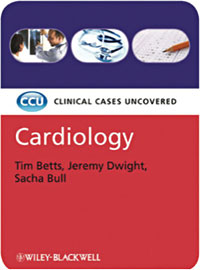Do we need yet another cardiology book? There are already scores of them – a simple internet search provides the evidence! Interestingly, Cardiology Clinical Cases Uncovered, a manageable compendium of 245 pages of cases, is immediately apparent on well known on-line book sales sites. Yes, we do need new cardiology texts. This book is contemporary, real world and targeted at a niche market – junior doctors and medical students.

Authors: Betts T, Dwight J, Bull S
Publishers: Wiley-Blackwell, 2010
ISBN: 978-1-4051-7800-6
Price £24.99
Betts, Dwight and Bull have delivered a commendable book concerning ‘everyday’ cardiology. They offer clinical scenarios and lead the reader through the presentation, examination, investigation and treatment, to discuss evidence-based management. The authors write in an open, comprehensible manner that encourages the reader to continue with ease through the 26 cases.
But who are the target audience? The authors suggest that it is primarily for medical students and junior doctors. I agree. It is also applicable to specialist nurses and nurse practitioners. There is an underlying theme of assessment, and the book is designed to complement the reader’s learning styles to this approach. For those interested in teaching, this book is worth the investment.
The book compromises 3 sections. In part 1 entitled ‘Basics”, there are essentially 37 pages of cardiology theory (anatomy, physiology, clinical skills, pathology and investigations). This section is well written and supported by a plethora of great diagrams. There is limited attention to imaging modalities, however, all are covered to some extent.
Part 2 entitled “Cases” is the main part of the book. It follows a question and answer approach, supplemented by many photographs and diagrams. The majority of the common and many of the rarer ‘classic’ cases are presented. The reader is guided through the cases, differential diagnoses are offered and the cases justified. The scenarios are, however, biased towards ECG interpretation.
Finally, part 3 looks at self assessment with 26 pages of MCQs, EMQs SAQ, and of course the answers!
Would I buy this book? Yes I would – but only as a reference for the purposes of teaching. I do not think that it is appropriate as an educational aid for trainees in cardiology.
At £25, (£19 on Amazon), the book offers good value for money. It is easy to read, clinically relevant, and should be appealing to medical students and junior doctors. It strengthens the Wiley-Blackwell series of ‘Clinical Cases Uncovered’ and would not go amiss on the book shelf of an aspiring cardiology trainee.
